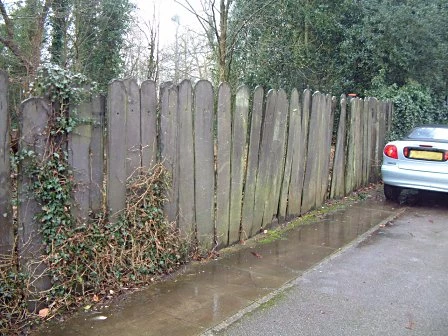Welsh slate discovered hundreds of miles from the quarries of North Wales
The slate pillar fence at Bisham (Windsor and Maidenhead). Approximately 150m (164 yards) of this fence survives, although local residents remember it as once being significantly longer. The pillars of Bisham's fence typically extend about 180cm (5.9 feet) above ground level and must have a further 40cm (1.3 feet) or so below the ground. Each pillar is some 20cm (7.9 inches) in width and 3.5cm (1.4 inches) thick.
How did a slate pillar fence come to be built in the Thames Valley, 300km away from the slate quarries of north-west Wales?
Slate pillar fences became common in north-west Wales from the middle of the 19th century. In 1861, the Penryhn Quarry at Bethesda, Gwynedd - one of the largest slate quarries in the world at that time - produced around 9,000 individual pillars. These pillars consisted of poor quality blue slate, typically about 150cm (4.9 feet) tall.
They were used to mark fields, gardens, railways lines and roads, with their simple construction being particularly well-suited to the harsh weather experienced by upland areas.
Despite their use around Wales's slate quarries, slate pillar fences are rarely found further a field. The discovery of a slate pillar fence at Temple House (now demolished) at Bisham, Maidenhead, is therefore extremely unusual. The bluish-purple colouring of the slate makes it certain that it was quarried in north-west Wales, probably at Penrhyn Quarry.
This raises the question of how a slate pillar fence came to be built almost 300km (186 miles) away from the source of the stone?
Temple House was built around 1790 for Thomas Williams, who owned the nearby Temple Mill copper works. Thomas Williams (1737-1802) was from north Wales originally and became the leading figure of the British copper industry. Williams employed the architect, Samuel Wyatt, to develop the Temple Mill copper works, and it is likely that Samuel also built Temple House.
Samuel Wyatt had very close links with the owners of the Penrhyn slate quarry. In 1782 he refurbished a building for Richard Pennant (later Lord Penrhyn), and in 1786 his brother became the general manager of the Penrhyn estate. This relationship ensured Samuel a regular supply of slates for his own business activities. In return, Samuel promoted the use of slate in the London area, using it for shelves, cisterns, lavatory-seats, window-sills and as a wall covering, as well as for roofing.
If the Temple House slate pillars had been supplied by Samuel Wyatt, their transport to Bisham could have been relatively simple. Even before the construction of a tramway from Penrhyn Quarry to the coast in 1801, there existed an efficient network of roads linking the quarry to the sea at Port Penrhyn.
From Port Penrhyn a fleet of vessels carried slate around the coast of the British Isles. The Wyatt family had an owning interest in many of these vessels. From London the cargo could be navigated up the Thames by barge.
There is therefore a great deal of circumstantial evidence linking the Bisham slate pillar fence with Samuel Wyatt and Penrhyn Quarry, and dating its construction to around 1790. But one aspect of the pillars' manufacture raises doubts about this. Some of the larger support pillars were clearly cut with circular saws - a technique which was not certainly used before 1805 and only became common from 1840.
One suggestion which unites these two strands of evidence is the possibility that the original fence was erected about 1790, but it had suffered from subsidence in the soft soil around Bisham. The result might have been a second order for Welsh slate around 1840 to rectify the problem.
The fence at Temple House may show evidence of the links between two of Wales's great industrialists, the copper magnate Thomas Williams and Richard Pennant of Penrhyn slate quarry, through the architect Samuel Wyatt. Both shared a common heritage, so what would have been more natural than for Thomas Williams and his architect to display the potential of Welsh slate beside his copper works at Temple Mill?
Background Reading
The Wyatts: an architectural dynasty by John Martin Robinson. Published by Oxford University Press (1979).
'Copper and Slate: Thomas Williams' Slate Pillar Fence at Bisham', by Dafydd Roberts. In The Marlow Historian, vol. 3, p16-21 (2003).
